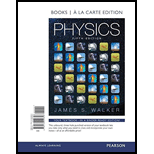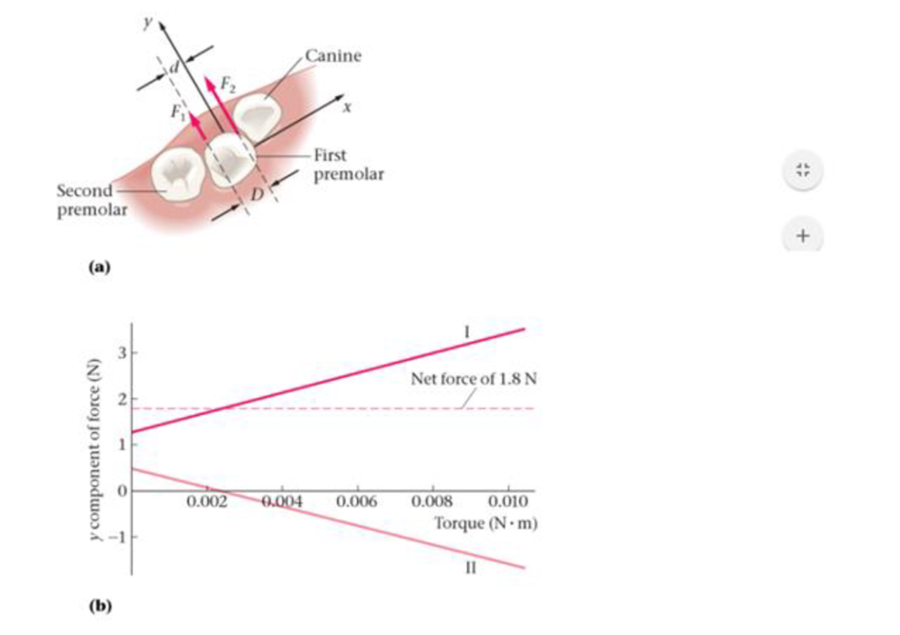
Concept explainers
BIO Correcting Torsiversion
Torsiversion is a medical condition in which a tooth is rotated away from its normal position about the long axis of the root Studies show that about 2 percent of the population suffer from this condition to some degree. For those who do, the improper alignment of the tooth can lead to tooth-to-tooth collisions during eating, as well as other problems. Typical patients display a rotation ranging from 20° to 60°, with an average around 30°.
An example is shown in Figure 11-69 (a), where the first premolar is not only displaced slightly from its proper location in the negative y direction, but also rotated clockwise from its normal orientation. To correct this condition an orthodontist might use an archwire and a bracket to apply both a force and a torque to the tooth. In the simplest case, two forces are applied to the tooth in different locations, as indicated by F1 and F2 in Figure 11-69 (a). These two forces, if chosen properly, can reposition the tooth by exerting a net force in the positive y direction, and also reorient it by applying a torque in the counterclockwise direction.

Figure 11-69 Problems 92, 93, 94, and 95
In a typical case it may be desired to have a net force in the positive y direction of 1.8 N. In addition, the distances in Figure 11-69 (a) can be taken to be d = 3.2 mm and D = 4.5 mm. Given these conditions, a range of torques is possible for various values of the y components of the forces, F1y and F2y. For example Figure 11-69 (b) shows the values of F1y and F2y necessary to produce a given torque, where the torque is measured about the center of the tooth (which is also the origin of the coordinate system). Notice that the two forces always add to 1.8 N in the positive y direction, though one of the forces changes sign as the torque is increased.
92. •• The two solid lines in Figure 11-69 (b) represent the two forces applied to the tooth. Which of the following statements about the two lines is correct?
- A. Line I = F1y, line II = F2y.
- B. The force indicated by line I changes sign.
- C. Line I = F2y, line II = F1y.
- D. The magnitude of the force indicated by line II is greater than the magnitude of the force indicated by line I.
Want to see the full answer?
Check out a sample textbook solution
Chapter 11 Solutions
Physics, Books a la Carte Edition (5th Edition)
Additional Science Textbook Solutions
Introductory Chemistry (6th Edition)
Human Anatomy & Physiology (2nd Edition)
Applications and Investigations in Earth Science (9th Edition)
Genetic Analysis: An Integrated Approach (3rd Edition)
Human Physiology: An Integrated Approach (8th Edition)
Campbell Essential Biology (7th Edition)
- 20. Two small conducting spheres are placed on top of insulating pads. The 3.7 × 10-10 C sphere is fixed whie the 3.0 × 107 C sphere, initially at rest, is free to move. The mass of each sphere is 0.09 kg. If the spheres are initially 0.10 m apart, how fast will the sphere be moving when they are 1.5 m apart?arrow_forwardpls help on allarrow_forwardpls help on thesearrow_forward
- pls help on all asked questions kindlyarrow_forwardpls help on all asked questions kindlyarrow_forward19. Mount Everest, Earth's highest mountain above sea level, has a peak of 8849 m above sea level. Assume that sea level defines the height of Earth's surface. (re = 6.38 × 106 m, ME = 5.98 × 1024 kg, G = 6.67 × 10 -11 Nm²/kg²) a. Calculate the strength of Earth's gravitational field at a point at the peak of Mount Everest. b. What is the ratio of the strength of Earth's gravitational field at a point 644416m below the surface of the Earth to a point at the top of Mount Everest? C. A tourist watching the sunrise on top of Mount Everest observes a satellite orbiting Earth at an altitude 3580 km above his position. Determine the speed of the satellite.arrow_forward
- pls help on allarrow_forwardpls help on allarrow_forward6. As the distance between two charges decreases, the magnitude of the electric potential energy of the two-charge system: a) Always increases b) Always decreases c) Increases if the charges have the same sign, decreases if they have the opposite signs d) Increases if the charges have the opposite sign, decreases if they have the same sign 7. To analyze the motion of an elastic collision between two charged particles we use conservation of & a) Energy, Velocity b) Momentum, Force c) Mass, Momentum d) Energy, Momentum e) Kinetic Energy, Potential Energyarrow_forward
 College PhysicsPhysicsISBN:9781938168000Author:Paul Peter Urone, Roger HinrichsPublisher:OpenStax College
College PhysicsPhysicsISBN:9781938168000Author:Paul Peter Urone, Roger HinrichsPublisher:OpenStax College Physics for Scientists and Engineers: Foundations...PhysicsISBN:9781133939146Author:Katz, Debora M.Publisher:Cengage Learning
Physics for Scientists and Engineers: Foundations...PhysicsISBN:9781133939146Author:Katz, Debora M.Publisher:Cengage Learning College PhysicsPhysicsISBN:9781285737027Author:Raymond A. Serway, Chris VuillePublisher:Cengage Learning
College PhysicsPhysicsISBN:9781285737027Author:Raymond A. Serway, Chris VuillePublisher:Cengage Learning University Physics Volume 1PhysicsISBN:9781938168277Author:William Moebs, Samuel J. Ling, Jeff SannyPublisher:OpenStax - Rice University
University Physics Volume 1PhysicsISBN:9781938168277Author:William Moebs, Samuel J. Ling, Jeff SannyPublisher:OpenStax - Rice University College PhysicsPhysicsISBN:9781305952300Author:Raymond A. Serway, Chris VuillePublisher:Cengage Learning
College PhysicsPhysicsISBN:9781305952300Author:Raymond A. Serway, Chris VuillePublisher:Cengage Learning Glencoe Physics: Principles and Problems, Student...PhysicsISBN:9780078807213Author:Paul W. ZitzewitzPublisher:Glencoe/McGraw-Hill
Glencoe Physics: Principles and Problems, Student...PhysicsISBN:9780078807213Author:Paul W. ZitzewitzPublisher:Glencoe/McGraw-Hill





